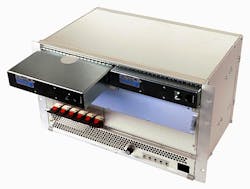Open-systems standards like SOSA could promote genuine embedded computing interoperability
Despite its advantages, however, there's a consistent rap against OpenVPX; critics say it's essentially a collection of proprietary embedded computing technologies masquerading as open-systems standards. The structure of OpenVPX allows a staggeringly wide variety of company-specific technologies, which can make interoperability among products from different suppliers difficult at best, and at worst can lock companies in to long-term supplier agreements -- just like the bad old days of proprietary architectures that a quarter-century ago gave rise to commercial off-the-shelf (COTS) designs in the first place.
That all may be changing, however, as an emerging industry standard called Sensor Open Systems Architecture (SOSA) catches on. SOSA, administered by The Open Group in San Francisco, revolves around OpenVPX, and focuses on single-board computers and how they can be integrated into sensor platforms. It involves a standardized approach on how embedded systems interrogate sensor data to distill actionable information.
More to the point, however, experts in the embedded computing industry say SOSA functionally is winnowing-down cumbersome OpenVPX standards into a useful subset for aerospace and defense applications. SOSA's potential to tame the OpenVPX monster could make interoperability of third-party embedded computing modules a reality, which could save costs and enhance competition in the embedded computing industry.
SOSA falls under an umbrella of emerging standards called Modular Open Systems Approach (MOSA). In addition to SOSA includes Future Airborne Capability Environment (FACE); Vehicular Integration for C4ISR/EW Interoperability (VICTORY); and Open Mission Systems/Universal Command and Control Interface (OMS/UCI).
One of the big difference between the MOSA standards and OpenVPX is serious participation of the U.S. military services on the standards committees; it's not just private companies formulating standards in hopes that will adhere to them. Military representatives are partnering with industry to help steer MOSA and SOSA to meet known and anticipated military needs.
"For the first time we are seeing the military services coming together and realizing that we have to have a collaborative approach," says David Pepper, senior product manager at embedded computing specialist Abaco Systems in Huntsville, Ala.
Ensuring that embedded computing modules from many different vendors will work and play well together in a variety of backplane databus architectures perhaps offers the biggest payoff of SOSA.
"Before, VPX was so loose that it was difficult to do interoperability," says Steve Gudknecht, product marketing manager at Elma Electronic Inc. in Fremont, Calif. "So then OpenVPX came out, and the user community did address some interoperability. Now, sitting on the standards boards are not just suppliers, but the Army, Navy, and Air Force. SOSA takes that OpenVPX standard and boils it down even further for interoperability and tri-branch convergence."
Military involvement in setting the MOSA and SOSA standards helps keep OpenVPX in a shape that's attractive to the military. "One of the objectives of SOSA and many other standards is to have complete interoperability of as many vendors possible in plug-and-play architectures -- to define the standards narrowly enough so that is possible, yet to have advanced functions available," explains Rodger Hosking vice president of Pentek Inc. in Upper Saddle River, N.J. "If the standard is too pen, the interoperability suffers."
Hosking and others in the embedded computing industry point out that SOSA is not yet a final standard, yet instead of enforcing specific approaches, it may help forge consensus among suppliers and users. "People will gravitate to things that other people are using, as an interoperable product," Hosking says.
Ready to make a purchase? Search the Military & Aerospace Electronics Buyer's Guide for companies, new products, press releases, and videos
